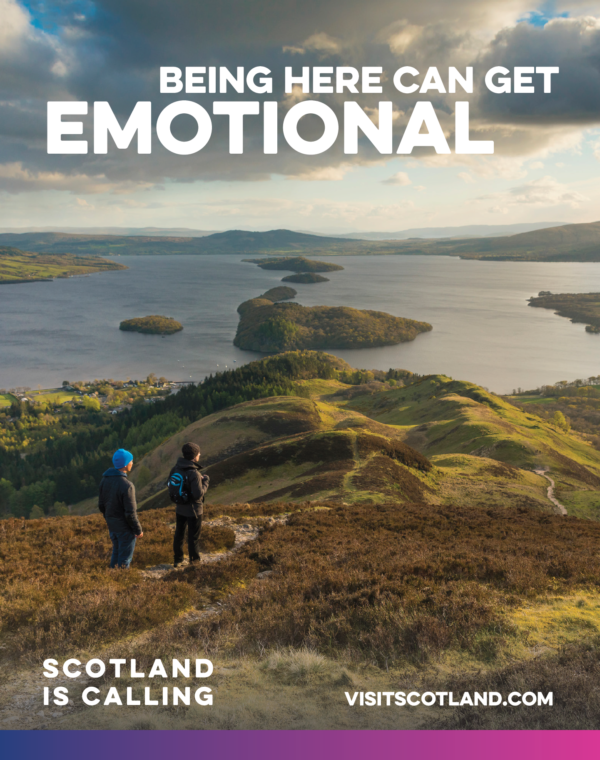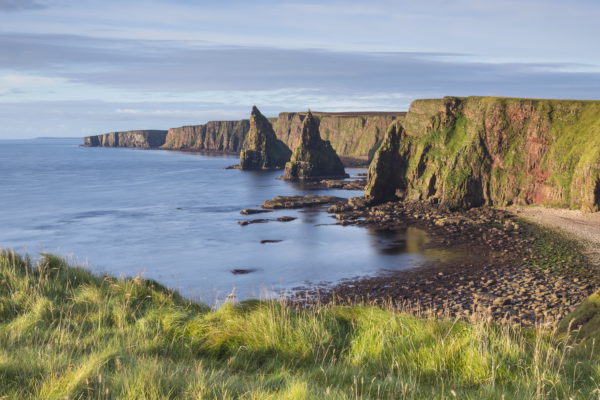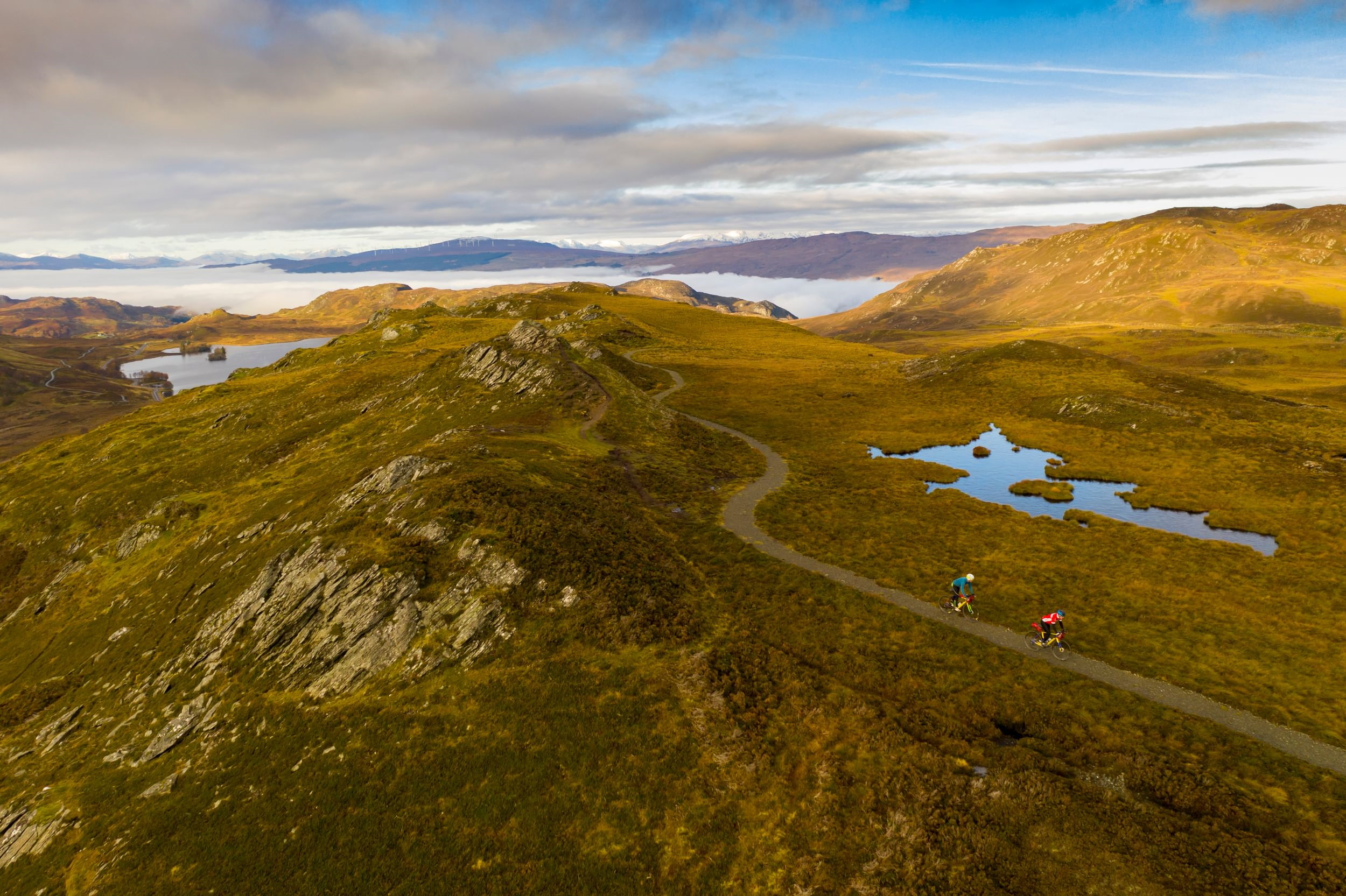Lord Thurso was appointed as Chairman of VisitScotland in 2016 and has significant travel industry experience. Lord Thurso and the team at VisitScotland today are responsible for promoting Scotland as not only the incredibly beautiful destination so many know it is, but also a sustainable destination for many to enjoy into the future. Lord Thurso took time to speak to the Scottish Banner from his home Caithness on how Scotland has managed the tourism downfall caused by the pandemic, what is happening in Scotland in 2022 and why Scotland really is calling so many to come back when they are ready to travel again.

Lord Thurso, you have had a long and varied career in the hospitality and tourism industry. With all your many years of experience how do you feel tourism will begin to rebound, particularly in Scotland, after the last two years?
The first thing is, for me, the core elements of what makes Scotland great, have not changed. And it’s a combination of all the environments: the built heritage, the natural environment, you’ve got the heritage and the history, and you’ve got fantastic people who are dying to do great things and a huge centuries long tradition of hospitality. So those core elements of why people love to come to Scotland are unchanged. So, I have absolutely no doubt that at a moment, we will recover back to where we were in 2019. And actually, go beyond that.
One of the most interesting things for me to remember is that in 2019, we had approximately 3.5 million overseas visitors come into Scotland, and they represented about 43% of the spend that we had. They’re incredibly valuable. Whatever it is about Scotland, that combination of things, it touches heartstrings and pulls people back. And I think that’s coming back. When I look back to the first three or four months of the pandemic and lockdown, and the moment when the entire hospitality industry, every element of tourism, the whole visitor economy was basically closed, I think there was about 10% of the industry that was open looking after key workers, but 90% closed. And I must admit, there were times that I did wonder how we will get through it. But in fact, the interesting thing was that people at home rediscovered they were in Scotland, which was tremendous.
As an example, my own little business here, I had people coming back to stay in cottages and play golf and fish and all these kinds of things and they said, “We haven’t done this for 20 years, we normally go to Spain, or somewhere else. This is rather fun. I think we’ll do this again.” Rediscovering your own country for Scots was quite interesting. What I think will happen and I suspect it will take a year or two to build right back up, but I think there is an immense pent-up demand for people to come back. I know so many other of the diaspora Scots, that I’ve been in touch with who say, “we just can’t wait to come back”, there is still that emotional pull to come back to Scotland. And it’s one of the huge advantages of brand Scotland is that people have an emotional attachment to Scotland, which is not something you say about every country. The enabler was always going to be the airlines coming back, and the ability to travel without doing umpteen million tests and all the other things and that is now beginning to happen. We’re seeing flights in and out of Glasgow and Edinburgh and connecting flights up from Heathrow. We are certainly expecting this summer to see something of a resurgence, but I suspect this year will be better than two years ago and last year, but not back to 2019 levels. I think 2023 will be close to 2019 visitor levels and I think 2024 will be exceeding 2019. So, I am hugely optimistic as to the fact that it will happen. I simply don’t know quite the timing.
2022 is Scotland’s Year of Stories, can you tell us more about what the year will hold for visitors to the country?

I thought it was a stroke of genius to come up with the idea of the Year of Stories, because in every part of Scottish tradition, is the tradition of telling tales. Going right back to the wonderful Celtic myths, and right back to the sagas of the Vikings. But then you add into that all the great storytellers, some of the obvious ones like Robert Burns or Sir Walter Scott, but also the modern storytellers and you’ve got Outlander, you’ve got TV, you’ve got films. So, there’s a huge canvas which to take pictures of Scotland. For example, the National Trust for Scotland have put together a range of products based on their places where you tell tales. For example, there is the Sir Walter Scott Trail and there is an Outlander Trail. So, the Year of Stories just gives everybody an opportunity to tell a tale about Scotland, and the visitor will find that all over Scotland, people are telling tales in lots of different ways. From the wonderful peat fire with a lovely peaty whisky and a tall tale of the evening, right through to the history and to modern times, and TV and film trails, there is such a story to tell.
Scotland’s tourism industry is really getting behind responsible tourism. Can you tell us more about just what that means and how visitors to Scotland can also be participants of responsible tourism?
Funnily enough, the genesis of what is now responsible tourism came from a way we began to think at VisitScotland about four years ago, so that predates a lot of what has come since. I remember saying to my colleagues I feel that the environment is something that we really ought to pay attention to, and I think it’s going to come up the political scale in every country in the world.
We began to look at how do we take carbon out of what we do, because tourism essentially is a good story as tourism brings wealth in. I’ve always defined economic activity of tourism as being to generate the maximum wealth for the minimum environmental and social disruption. But on top of that, being a tremendous wealth generator for the country. It also enhances our wellbeing, and we are all understanding of mental health following two years of isolation and lockdowns. Tourism also spreads understanding and friendship and I am a huge believer in the fact that tourism is a force for good.
So internally, we’ve decarbonized, hugely. Interestingly, one of the things is I don’t travel nearly as much as I used to, but I’ve learned to do things like video conferencing and much more online. We’re great believers in reusing if we possibly can, and recycling if we can’t reuse, and working towards a minimum waste.
We have got a couple of initiatives, one of my favorites was to encourage the use of electric cars on the touring routes, and to talk to some of our big electricity providers about putting in more electric charging points and encouraging more accommodation providers to have electric charging points. And that if you like is all about environmental sustainability, then there’s the community sustainability, which is the other half of it, which is about having a positive impact in the community by supporting jobs and wealth creation and not having a negative one by trashing the place and blocking the roads or whatever it may be. And the two actually go hand in hand.
So, it’s responsible tourism which is the beginning of a journey. It’s about encouraging people to be responsible when they’re here and encouraging businesses to offer a product that is naturally green.
Has the legacy of the recent COP26 (UN Climate Change Conference) event in Glasgow further driven how the Scottish travel industry can show the world just how tourism and sustainability can work together?
I think interestingly, the first thing I’d say is Glasgow appeared on the world stage day in day out for two weeks, and most of the coverage was fantastic. It demonstrated to the world that a major conference can be staged in Glasgow, and there’s no other city in the UK that’s done that. So, the knock-on effect of showing the world just how good we are at major events was a huge plus for the future and I think we will get a lot of business coming into Glasgow and Edinburgh on the back of COP26.
My sense was that for the first time probably ever in the history of COP conferences that there was a huge willingness to try and achieve something, and it was the first conference where coal was allowed to be discussed, and a kind of no coal future was part of the conference. I think that reflects the fact that really, everybody now gets that the manmade heating of the planet is not going to be a terribly good thing. And if we want to preserve the planet, in the way we like it, then we’re going to have to do something about it. One of the things I learned about it was that a large chunk of it is going to be about changing behavior, but it’s also going to be about technology. I see the unbelievable advances that are taking place, literally in the space of two or three years, which is going to be a huge difference. Some of the technologies we think we’re going to be able to invent, but we haven’t invented yet. Scotland certainly took COP26 to its heart, and what a wonderful way to introduce people to Scotland, and Glasgow, but through one of the most important conferences for one of the most important topics that has ever taken place. So, I thought it was fabulous, and we’re doing everything we can to build on that.

Last year VisitScotland became the first National Tourist Board to declare a Climate Emergency. Can you tell us why that was so important for VisitScotland to do and how you aim to play a leading role in the development of Scotland as a globally recognised responsible destination?
I am absolutely convinced that the generations that are coming along, they want to enjoy a destination, they want experiences, but they want to do it responsibly. And if they have a choice between somewhere that takes account of that and was working hard on sustainability, and somewhere else that doesn’t, I think they will choose the sustainable product every time. I think it’s in part about doing the right thing, but I think it makes huge economic sense. And I think that’s what really will drive this. And I’m convinced if we can say, we’ve created a visitor experience that doesn’t use any carbon, I think that’s a choice that people will make. I see it as one of the things that within the next few years will become one of our great unique selling points. Scotland is not only a beautiful place, but it’s a sustainably beautiful place, and one the visitor can enjoy sustainably.
Scotland is such a varied destination with incredible natural assets, creative and vibrant cities and coastlines that transport you to another time. For a relatively small country it more than packs in much for the visitor, how easy, or hard, is it to showcase the huge variety Scotland has to offer to potential visitors?
Well, the wonderful starting point is that virtually everybody in the world is heard of Scotland. All across the world in Africa and Asia and beyond armies have regiments with pipes and drums. It’s one of those extraordinary exports that exists. There is a reach from Scotland, that goes right across the world that very few other countries have. Are problem to a certain extent is that reach is bagpipes, shortbread, and Edinburgh Castle.
The great thing is to look at that hook of the fact people know something about Scotland and give them the rest of Scotland. That plays into our current campaign, Scotland is Calling, which is all about understanding that there is emotion involved, and it is about appealing to people’s emotions and appealing to how people feel about Scotland.
What you appeal to is the sentiment, what you appeal to is the sense of experience. If we offer an experience that’s clearly got emotion behind it and feeling, we get far more hook into people.
You come from Caithness in the north of Scotland, an area often untouched by tourists. Can you tell us a bit more about this special region and perhaps why visitors should consider it on their next visit?

Photo: VisitScotland/Kenny Lam.
The first thing I’d say is Caithness is an example of lots of bits of Scotland which are slightly off the beaten track. I have had the privilege as Chairman of VisitScotland to visit huge amounts of Scotland that I had never seen before and there really is just so many different places that offer something different. So, I would encourage people to come to Caithness but also to lots of different parts, for example if you go into Dumfries and Galloway and locations like that, as there’s huge, wonderful places off the beaten track. I visited several spots in the country that are such a pleasure to see like across Aberdeenshire or visit the whisky trail. Scotland offers a rich smorgasbord of experiences for everybody to enjoy.
Caithness is a wonderful county; several writers have described it as being beyond the Highlands. The names up here are mostly Norse, and we have a huge amount in common with the Orkney Islands and people often describe Caithness as an island that didn’t manage to get through. I think we have spectacular coastal landscapes, stunning sea birds, and then right up butting up against these beautiful Heather headlands.
Then, in the middle of the county, you have the blanket bog, known as the flow country, which is taken from a Norse word meaning wet boggy place and the flow country of Caithness and Sutherland is the largest blanket bog in the world. There are more carbons sequestered in the peat of Caithness and Sutherland than in the entire Amazonian rainforest. It’s a stunning world class environment and we are very hopeful it will become a UNESCO World Heritage Site. Of course, I happen to think that the people of Caithness are among the most special of Scots and we have a reputation for very warm hospitality.
The international Scottish community has always been a strong driver of inbound tourism to Scotland. How important does this market continue to be for Scotland and what message do you have for the Scottish Diaspora now getting ready to make plans to come back ‘home’ for a visit?
My message is we’re here with open arms ready and willing to look after you. It’s Haste Ye Back, but when it’s safe, and you’re comfortable to do so. I think that level of comfort is coming this year and so what we always say to everybody is, is that “Scotland is Calling”, we’re calling out to you, we are here, we love you, we remember you, and we’re ready to look after you as and when you are ready. But do it when you’re comfortable. So hopefully across the globe, the Scottish diaspora is getting ready to come back and when people feel they’d like to, we’re ready to welcome them. It’s always good to see the diaspora coming back and we so appreciate how much they amplify the sound of Scotland in their communities and teach non-Scots what fun it is to come and be in Scotland. I’m hugely grateful for the fact that all the organisations across America, Canada, Australia, New Zealand, and the rest of the world, do such a really great job in helping us promote Scotland.
Plan your next trip, or be inspired to VisitScotland at: www.visitscotland.com

